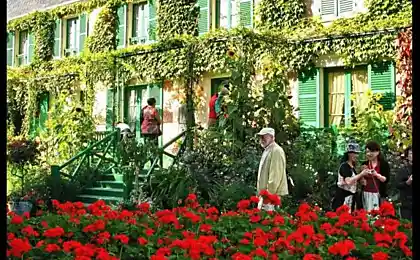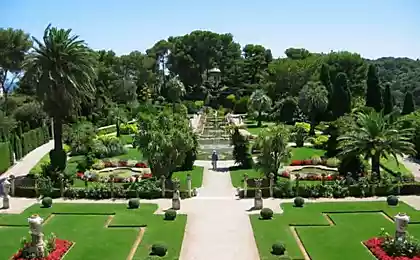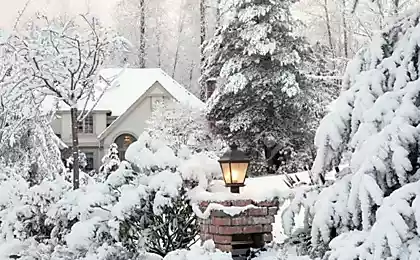707
Mystic Garden prisoners
The eruption of Mount Vesuvius in 79 AD and is considered the most devastating of all known eruptions. The volcano threw a deadly cloud of rock, ash and steam to a height of 30 kilometers, spewing molten lava at a rate of 1, 5 million tons per second. Lava flow has been completely wiped out Pompeii, thousands of its inhabitants were buried alive.
8 photos.
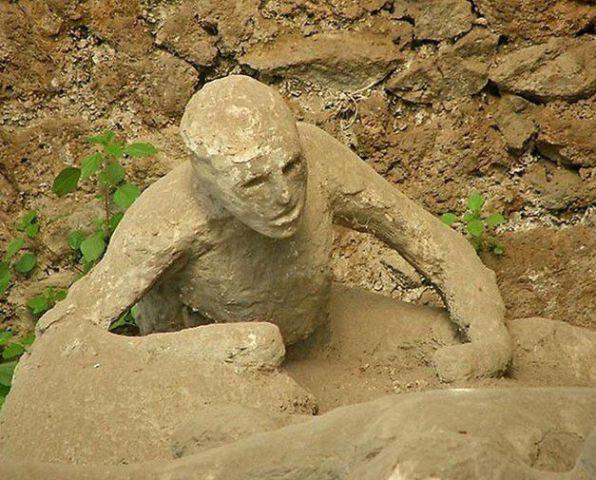
At first, few inhabitants of Pompeii drew attention to a cloud of ash and steam that rose above the volcano Mount Vesuvius on Aug. 24, 79 AD, Vesuvius in fact has long been considered a asleep volcano. Soon, black clouds covered the sky over the city, flakes of ash settled on rooftops, pavement, trees. Ash had to constantly shake off clothes. Under a layer of bright colors faded city, merging into a single gray background. Continuous tremors rocked the ground constantly. The earthquake was so strong that the carts in the streets began to capsize, but with houses falling statues and crumbling tiles. On the street you can get out, only covering head with a pillow, because after the ash began to fall from the sky and stones. Anxiety of people is growing.
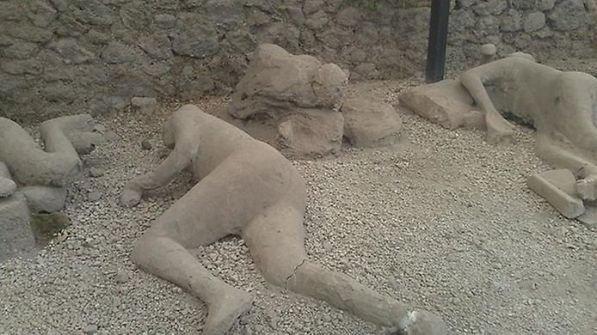
Rising from the crater of the volcano reached the pole height of 20 km. Many people tried to hide from the ashes of the houses, but they quickly filled the air poisonous sulfur fumes and people died from suffocation. Under the weight of the ashes of roofs collapsing on occupants who had taken refuge in them. Many died, unable to leave valuables. During the excavations were found a lot of people with bags full of gold and other jewelry. At the time of the eruption, many Pompeians were in the theater, which hosted the presentation or gladiators.
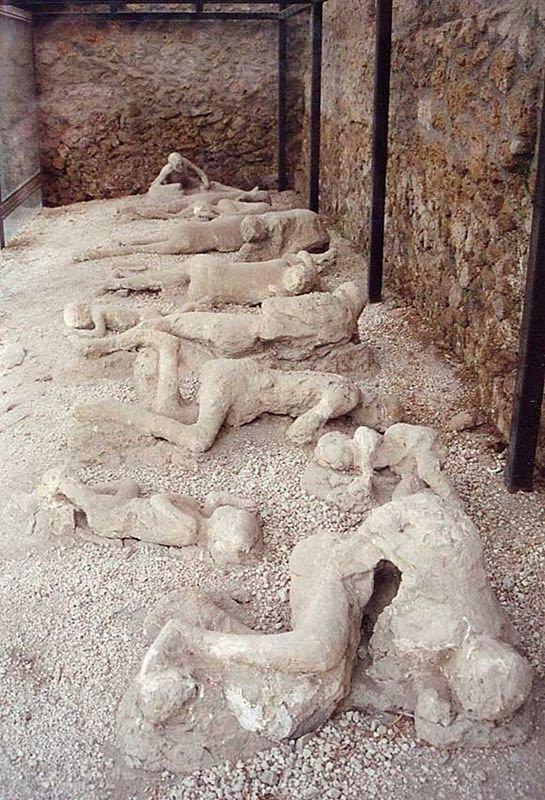
The explosion was extended in time, so most of the residents had to leave the city of Pompeii. The city remained slaves who left specifically to protect household property and citizens, stubbornly refused to leave their homes. The next morning greeted the remaining people in the vicinity of the pitch darkness, the air was hot. The eruption of Vesuvius destroyed Pompeii completely. The town disappeared under a layer of ash, the thickness of which reaches 3 meters. Together with Pompeii died several neighboring cities of Herculaneum, Stabia and Oktavianum.
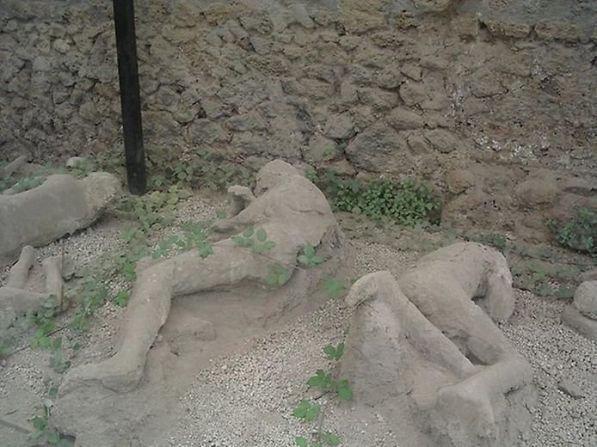
Located on the other side of the volcano city Herculaneum was filled with ash falling, but he, too, disappeared from the face of the earth. After the eruption of the volcano on the slopes accumulated a lot of ash which, like an avalanche, could collapse at any moment. It started to rain washed away all the ash from the slope and raced Herculaneum powerful hot mud flows, the depth of which at times reached 15 m. They are flooded and Herculaneum. However, most of the population has left the city during the eruption.
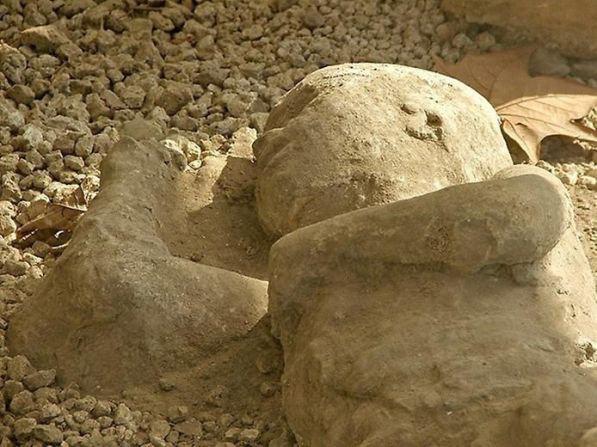
Based on the number of skeletons found, it is believed that the city lost about 2 thousand. People, while the entire population of Pompey in the thousands of 20-30. Killing those who expected to sit out the danger crouching somewhere in a nook at home, such as in a remote corridor or in the cellar, or those who came too late - after the rain has passed a stone. The hard way through the piles of small stones, which sank in the legs, they were caught by the rain of ash and, from exhaustion, suffocated beneath. Most bodies found in this upper layer of ash.
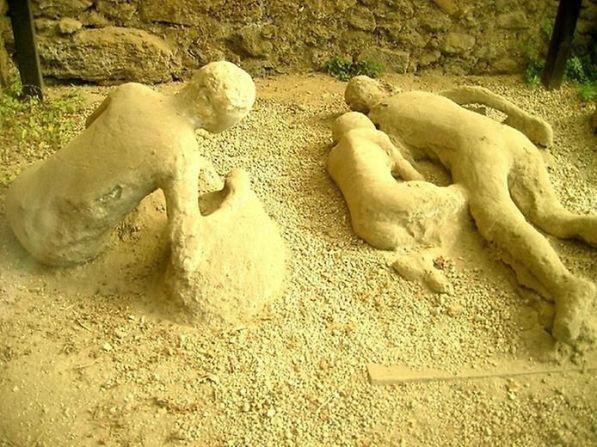
Along with ashes, or immediately after it poured hot shower; water mixed with ash, formed a mass that clung tightly dead bodies, entering into all the folds of clothing, all the grooves on the body, all the wrinkles. Weight of the dried up and matured, while maintaining the exact imprint of lying in her body. After its disintegration and decay in her left an empty space where lay the skeleton of the deceased. One of the leaders of the excavation, Fiorello, came up to fill these voids plaster solution: set gypsum is an exact replica of the deceased and with absolute fidelity to transmit his position and even facial expression at the time of death. These molds were kept up to World War II in a small Pompeian museum, built at the Sea Gate.
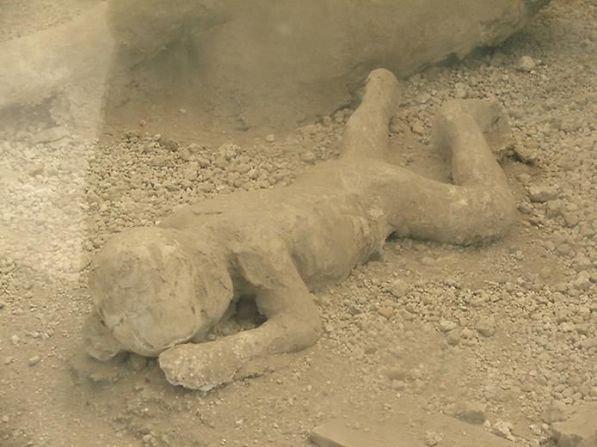
At this place it was once an ancient garden, which is now called the Garden of Captives. Here visitors opened 13 fossilized bodies of victims of the terrible eruption.
Everything!
Source
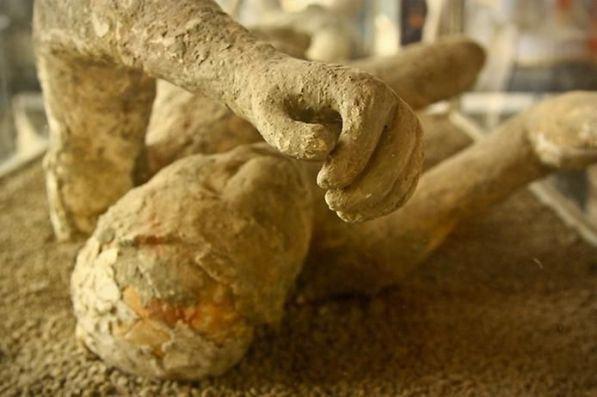
Source:
8 photos.

At first, few inhabitants of Pompeii drew attention to a cloud of ash and steam that rose above the volcano Mount Vesuvius on Aug. 24, 79 AD, Vesuvius in fact has long been considered a asleep volcano. Soon, black clouds covered the sky over the city, flakes of ash settled on rooftops, pavement, trees. Ash had to constantly shake off clothes. Under a layer of bright colors faded city, merging into a single gray background. Continuous tremors rocked the ground constantly. The earthquake was so strong that the carts in the streets began to capsize, but with houses falling statues and crumbling tiles. On the street you can get out, only covering head with a pillow, because after the ash began to fall from the sky and stones. Anxiety of people is growing.

Rising from the crater of the volcano reached the pole height of 20 km. Many people tried to hide from the ashes of the houses, but they quickly filled the air poisonous sulfur fumes and people died from suffocation. Under the weight of the ashes of roofs collapsing on occupants who had taken refuge in them. Many died, unable to leave valuables. During the excavations were found a lot of people with bags full of gold and other jewelry. At the time of the eruption, many Pompeians were in the theater, which hosted the presentation or gladiators.

The explosion was extended in time, so most of the residents had to leave the city of Pompeii. The city remained slaves who left specifically to protect household property and citizens, stubbornly refused to leave their homes. The next morning greeted the remaining people in the vicinity of the pitch darkness, the air was hot. The eruption of Vesuvius destroyed Pompeii completely. The town disappeared under a layer of ash, the thickness of which reaches 3 meters. Together with Pompeii died several neighboring cities of Herculaneum, Stabia and Oktavianum.

Located on the other side of the volcano city Herculaneum was filled with ash falling, but he, too, disappeared from the face of the earth. After the eruption of the volcano on the slopes accumulated a lot of ash which, like an avalanche, could collapse at any moment. It started to rain washed away all the ash from the slope and raced Herculaneum powerful hot mud flows, the depth of which at times reached 15 m. They are flooded and Herculaneum. However, most of the population has left the city during the eruption.

Based on the number of skeletons found, it is believed that the city lost about 2 thousand. People, while the entire population of Pompey in the thousands of 20-30. Killing those who expected to sit out the danger crouching somewhere in a nook at home, such as in a remote corridor or in the cellar, or those who came too late - after the rain has passed a stone. The hard way through the piles of small stones, which sank in the legs, they were caught by the rain of ash and, from exhaustion, suffocated beneath. Most bodies found in this upper layer of ash.

Along with ashes, or immediately after it poured hot shower; water mixed with ash, formed a mass that clung tightly dead bodies, entering into all the folds of clothing, all the grooves on the body, all the wrinkles. Weight of the dried up and matured, while maintaining the exact imprint of lying in her body. After its disintegration and decay in her left an empty space where lay the skeleton of the deceased. One of the leaders of the excavation, Fiorello, came up to fill these voids plaster solution: set gypsum is an exact replica of the deceased and with absolute fidelity to transmit his position and even facial expression at the time of death. These molds were kept up to World War II in a small Pompeian museum, built at the Sea Gate.

At this place it was once an ancient garden, which is now called the Garden of Captives. Here visitors opened 13 fossilized bodies of victims of the terrible eruption.
Everything!
Source

Source:







